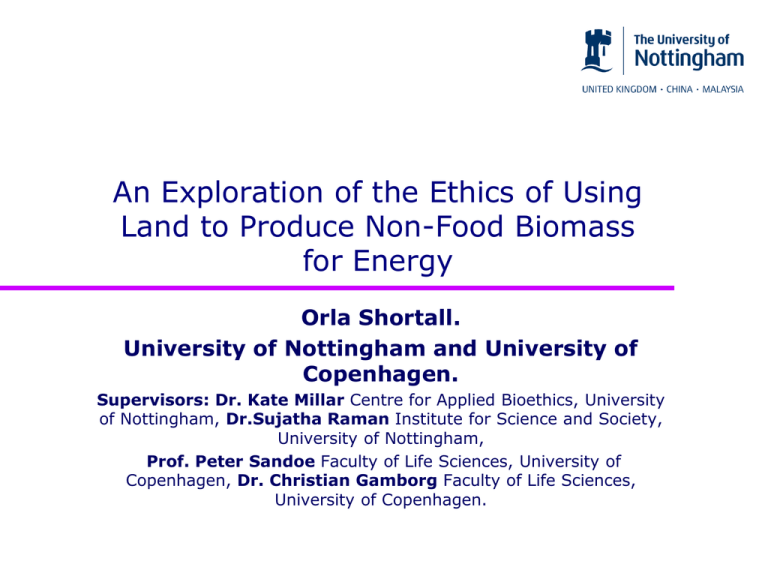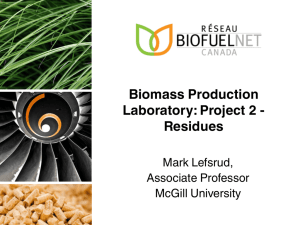An exploration of the ethics of using land to produce non
advertisement

An Exploration of the Ethics of Using Land to Produce Non-Food Biomass for Energy Orla Shortall. University of Nottingham and University of Copenhagen. Supervisors: Dr. Kate Millar Centre for Applied Bioethics, University of Nottingham, Dr.Sujatha Raman Institute for Science and Society, University of Nottingham, Prof. Peter Sandoe Faculty of Life Sciences, University of Copenhagen, Dr. Christian Gamborg Faculty of Life Sciences, University of Copenhagen. Introduction Background Interests Methodology Empirical work Introduction What is biomass energy? - Biomass: living or recently living matter. - Biomass energy: any energy derived form biomass. - Bioenergy: electricity or heat produced from biomass. - Biofuels: liquid fuel used in the transport sector. Currently food crops – corn, sugarcane, palm oil etc. Introduction - Post-normal science High uncertainty: epistemological, ethical. High stakes: environmental. Make values explicit and manage uncertainty. Funtowicz, S.O. and Ravetz, J.R. (1993) “Science for the Post-Normal Age” Future (3): 739-755 - Project: comparative study UK and Denmark. Make values explicit in debates about bioenergy governance. Examine framing of debate. Conduct ethical analysis. 4 Background UK Population: 62m Land Area: 243,000km Population Density: 255 people/km Arable Land: 23% Agriculture as % of economy: 0.7% Renewable Energy Consumption: 3% Biofuels in transport: 3% Denmark Population: 5.5m Land Area: 43,000km Population Density: 129 people/km Arable Land: 53% Agriculture as % of economy: 1.2% Renewable energy consumption: 20% Biofuels in transport: 0.2% 5 Background Reasons to produce biomass energy Energy Security Climate Change Mitigation Rural Development 6 Background Controversies surrounding biomass energy: biofuels. Food versus Fuel Environmental Impacts Social Justice 7 Background Policy Responses UK - Slow down targets for biofuels. Less emphasis on food-based biofuels. But grant planning permission to biofuels plants. Denmark Adopt official targets. But very little food-based biofuels. EU: Establish criteria for voluntary sustainability schemes. All: Fund research into non-food biomass. 8 Background Non-food Biomass What is it? Wood pellets, crop residues like straw, purpose grown crops like willow, grasses. How is it used? Currently bioenergy. - “Second generation” biofuels. Combined use – biorefinery. How does it work? - - Bioenergy: burned. Biofuels: sugar extracted and fermented into ethanol. Biorefinery: both. 9 Background Non-food biomass – perceived advantages More environmental friendly: fewer inputs, grow on marginal land – no ILUC. No food v fuel: not food crops, use marginal land/crop residues. More efficient and high yielding: higher energy yield/ha, use all parts of crop, GM. 10 Interests Use of agricultural land for nonfood biomass. Non-food biomass still uses land. Involves land use change. Uncertainty in agricultural production systems. How responsible? Effects on agricultural systems. 11 Interests Use of agricultural land for nonfood biomass. Types of land. Marginal land. Other uses. Environmentally vulnerable land. Production ethic. Productionism. Efficiency. Thompson (1995) The Spirit of the Soil Routledge London Produce fuel frugally in a commodities market? Feasible? 12 Interests Land and Technology GM: discourse of efficiency. Malthusian technocratic defence of scientific progress. Philosophical objections: freedom from and control over nature. Ethically problematic. Practical: doesn’t fix problems and creates new problems. 13 Interests Land and Technology Biomass for energy: natural or technological? “Plants are able to absorb and store solar energy without technological intervention” WGBU (2008) Future Bioenergy and Sustainable Land Use London WGBU Cyborg crop. “Late twentieth century machines have made thoroughly ambiguous the difference between natural and artificial, mind and body, self-developing and externally designed and many other distinctions that used to apply to organisms and machines.” Haraway (2004) “They Cyborg Manifesto” in Readings in Philosophy of Technology (ed.) Kaplan Oxford Rowman and Littlefield How metaphorical or literal language of perfection? 14 Interests Land and Society Three policy objectives. Energy security. Environmental accountability. Short term or long term solution? Other objectives. Competing uses. 15 Interests Land and Society Why use land for energy? Other uses of land, other technologies, other solutions. Place for agrarian land ethic in debates about biomass energy? Thompson (2007) “The agricultural ethics of biofuels: a first look” Journal of Agricultural and Environmental Ethics 21: 183-198 More limited resources = greater appreciation? Import way out of problem? 16 Interests Overarching Question What does it mean to use land in an ethical way to produce non-food biomass for energy? Broad interest in intersection of people, land and technology in relation to biomass energy. Explore the values implicit in debates and how ethical uncertainty is framed and managed in the governance of biomass energy development. 17 Methodology Social Sciences and bioethics – how to combine? Deconstruction and reconstruction Deconstruction. STS - “analytic process by which scientific claims are disentangled into their material, social and rhetorical components.” Jasanoff, S. (1999) “STS and Public Policy: Getting Beyond Deconstruction” Science Technology and Society (4) :59-72 Deconstruction. Environmental Pragmatism –”method of refuting an interpretation or view of the world by exposing implicit or locally contingent elements of its logic.” Thompson, P. (1996) “Pragmatism and the case of water” in Environmental Pragmatism (eds.) Light, A. and Katz, E. New York, Routledge 18 Methodology Social Sciences and bioethics – how to combine? Constructivism. STS - “its ultimate aim is to piece things together constructively, combining the heterogeneous elements into richer pictures of complex systems and activities.” Jasanoff, S. (1999) “STS and Public Policy: Getting Beyond Deconstruction” Science Technology and Society (4) :59-72 Reconstruction. Environmental Pragmatism – “Reconstruct a broader and more inclusive community”. “Reconstruct common visions of life and purpose on more honestly social (and hence quite temporary) foundations.” Thompson, P. (1996) “Pragmatism and the case of water” in Environmental Pragmatism (eds.) Light, A. and Katz, E. New York, Routledge 19 Methodology Social Sciences and bioethics – how to combine? Both – emphasis on engaging with policy. Context dependency. Framing and ethical analysis. 20 Methodology Uncertainties What does reconstruction look like? How use theory in environmental pragmatism? Context dependent. Role of policy. 21 Empirical Work Explore the framing of these issues through interviews with: Scientists. Industry representatives. Policy makers and civil society organisations. 22 Empirical Work Timetable: 3 work packages, 4 months each, divided between UK and Denmark. Interviews: Focus groups/workshops/individual interviews. Access: Through project partners. 23 Conclusion Controversial, resource intensive technology. Interested in intersection of people technology and natural world. Ethical character of biomass production and use. Pull apart and rebuild issues. 24 Thank you for your attention Acknowledgements: Dr. Kate Millar, Dr. Sujatha Raman, Prof. Peter Sandoe, Dr. Christian Gamborg. University of Nottingham and University of Copenhagen.




